Whether you are staging a house to sell or using interior photos for a blog or publication, there are a few things I’ve learned over the years about photographing a home that makes all the difference for those viewing them. And although I am NOT a professional photographer, there are things I wish all real estate photographers would do. This article will address those things and also help you improve your own photos.
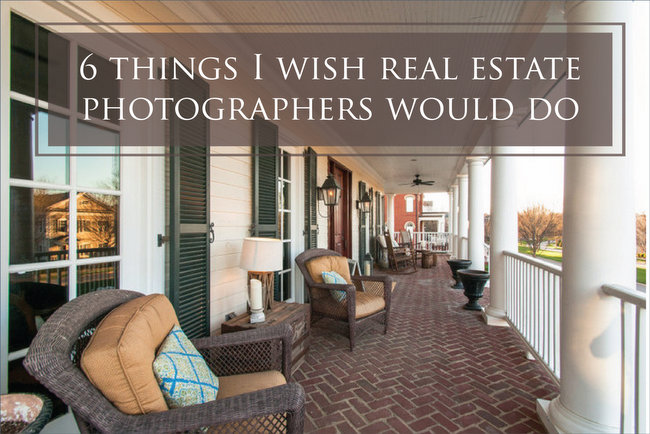
1. Get more flooring, less ceiling.
I don’t mean to pick on them, BUT some real estate photographers tend to capture a whole lot more of the ceiling than they do the flooring. This is only good when there’s a coffered ceiling or something really special up there. If you need photos of rooms with hardwood floors, you want to be sure to get as much of that architectural detail in your photos as possible. AND, the more flooring you get in a shot, the larger the room appears. So I let the photographer I’m working with know on the front end so they make a point to lower their tripods to get the kind of shots I’m looking for.
I’d really rather not feature a boob light like this one:
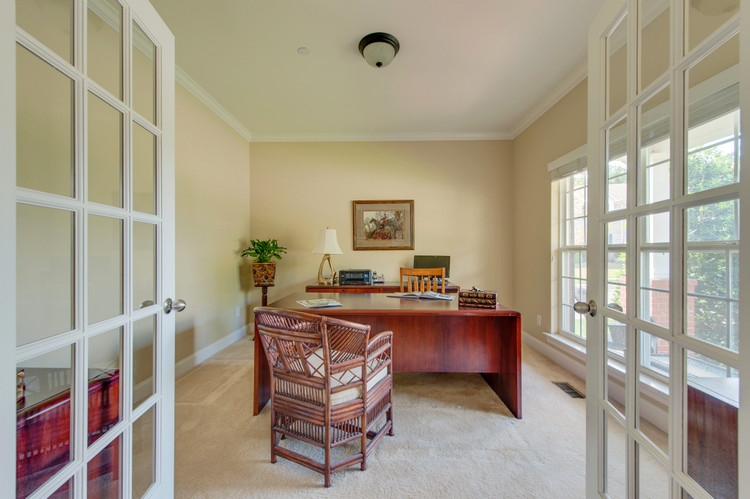
It wasn’t necessary or helpful to include so much ceiling in the first photograph. The unimpressive ceiling light is the first thing I notice in the photo above, while the french doors are more the focal point in this photo:
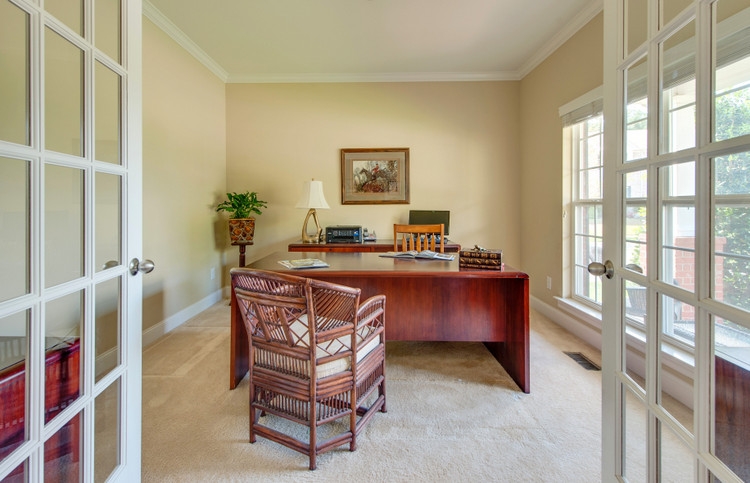
If you are taking your own photos, you may learn that photographing rooms can be more physically grueling than arranging the furniture. Why? THE SQUATTING. You may have to squat to get your camera to where it’s a bit above table level (of a dining table or dresser), so you’re not looking down on what you are photographing. As a woman of 5’7 in bare feet, that requires doing a little mini squat to get the camera where I want it. Depending on your height, this may require a stool you can move around and sit on to get your shots. If you do squat, it’s best to steady yourself against a wall or piece of furniture. Steady as she goes – and hold your breath, so as not to shake the camera.
2. Don’t use artificial lighting.
Most real estate photographers turn on ALL the lights in a room when taking photos for a listing.If you want to capture paint and furnishing colors accurately (and you do), for goodness sake, DON’T turn on artificial lights in the room – no overhead, no lamps, no nothing. If it’s nighttime – well, just wait for daytime to take your photos. Artificial lighting may skew the colors yellow (incandescent and soft white LED) or blue (fluorescent and day light LED). And the worst is when the bulbs in a room are a mix of these!
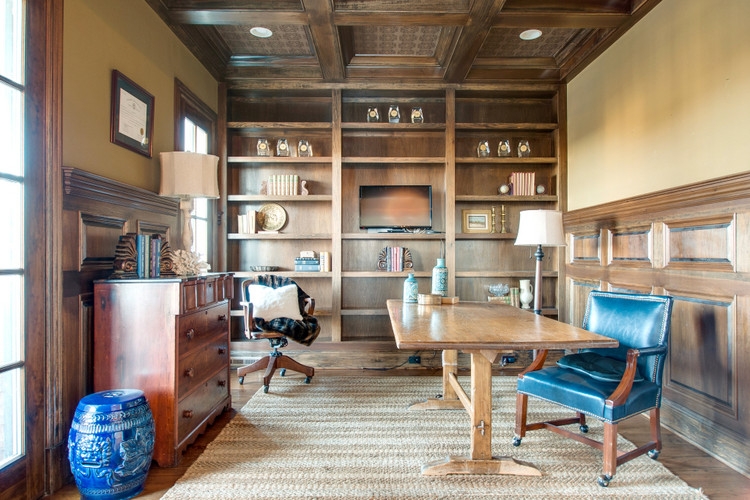 Staging by Expert Psychological Stager™ graduates, shot with natural light by Showcase Photographers
Staging by Expert Psychological Stager™ graduates, shot with natural light by Showcase Photographers
If you are taking your own photos, try to take them with natural light coming in behind you, then edit the photos after the fact to lighten if needed. Shooting towards windows that have light streaming in can result in dark photos. Here’s a trick: depending on if you are using a cell phone or DLSR camera, learn how to “meter” onto a dark part of the room. There’s a way to make your camera hold that setting while you take a shot facing the light-filled window, so that the camera doesn’t darken the entire room. Mine requires me to push the main button down half-way while shooting towards a darker spot of the room, then simultaneously pushing another button to hold that setting while I direct the camera where I actually want to take the shot. On a newer iPhone, you can either tap on the part of the screen that you want the camera to illuminate, or you can tap then slide the sunshine symbol to the right of the box that appears to lighten the photo as much as you like.
3. Take photos from the right angles.
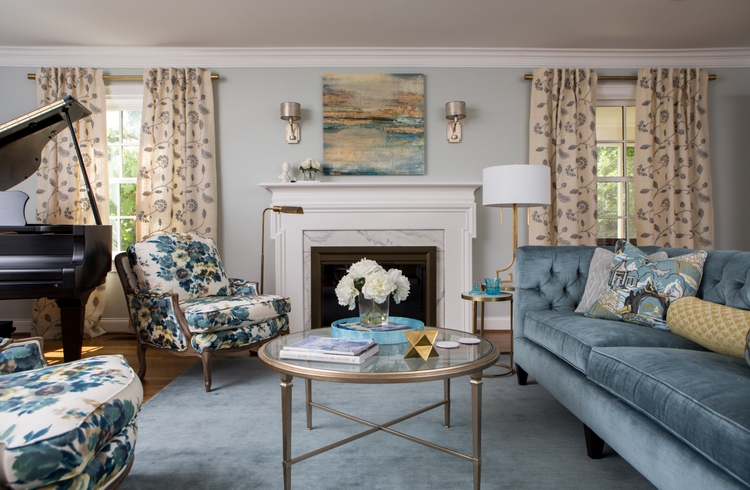 The Decorologist photography by Sqft
The Decorologist photography by Sqft
Although real estate photographers typically take photos from the entry and corners, they often fail to take photos head-on facing focal points of each room. One of the goals of Psychological Staging™ is to put the emphasis on the architecture (which is what you are selling) rather than the decor. Taking photos facing the focal points and the architectural details help meet that goal and make for more compelling photographs that look more like magazine shots than real estate shots.
4. Beware the wide angle lens.
Pretty much all real estate photographers utilize a wide angle lens. It enables them to capture a space all the way across, so that a viewer can get a better understanding of the room’s layout and its connections to other rooms. However, the use of a so-called fisheye lens is deceptive. It makes the rooms look SIGNIFICANTLY larger than they are in reality, which can be a big let-down when buyers tour the home. Like this bedroom, which looks ridiculously ginormous:
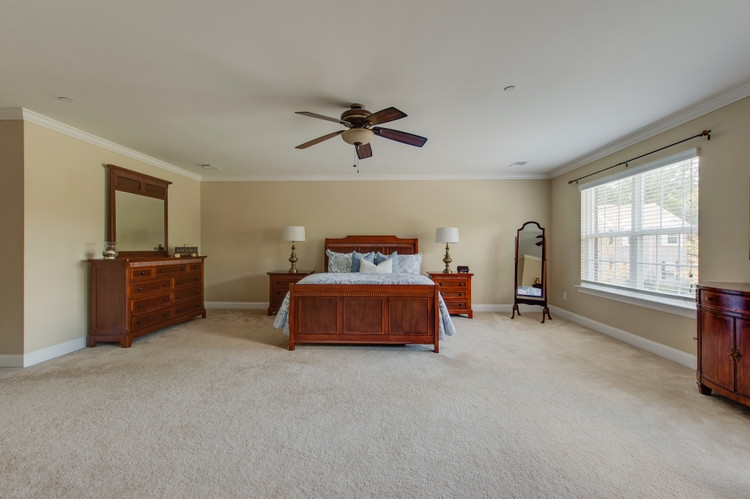
This lens can also cause major distortions, such as making a chair arm look about six feet long . . .
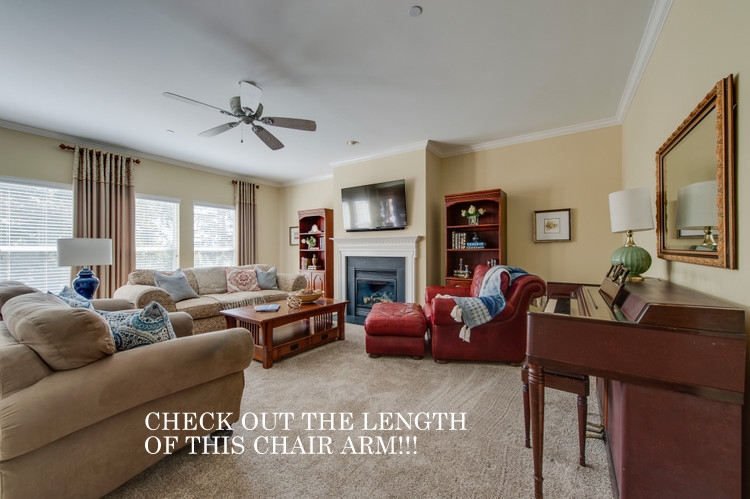
The fisheye lens made this chair’s arm so distorted and long that it draws more attention that the architecture of the space, which is definitely NOT what we want.
5. Give us the hi-res (not web-sized) photos:
Even if you are planning on using web-sized photos for your blog or social media, make sure to request hi-res photos from your photographer. I never mess with the web-sized ones, and here’s why: I may want to crop the image to create a vignette shot (close-up shot of a certain element in the room) or to correct a shot that has too much ceiling or distorted edges. If they are delivered to you web-sized, any cropping you do will make your photos too small to use.
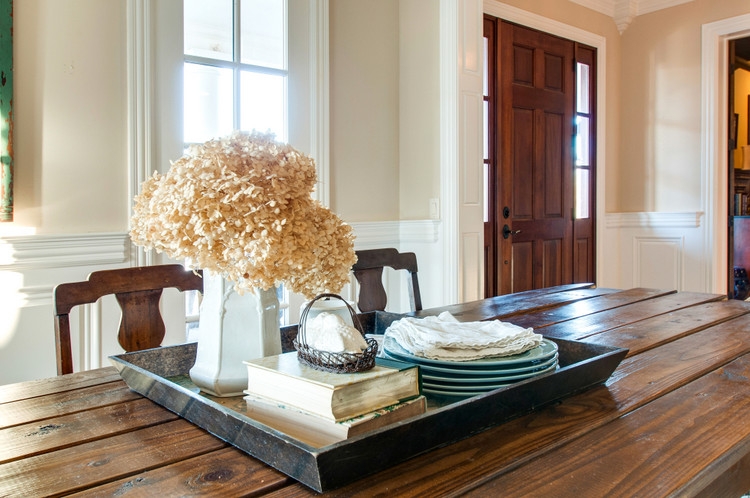 Staging by Expert Psychological Stager™ graduates, photography by Showcase Photographers
Staging by Expert Psychological Stager™ graduates, photography by Showcase Photographers
6. Take care of wires, outlets, and distractions.
Real estate photographers are good about editing to make sure their work is well-lit and bright, but they usually don’t edit out unsightly wires or other unfortunate distractions in the space. I wish they would! Of course, that is something you can do yourself with simple photo editing software. While I would never edit out something that would be deceptive to a buyer, there is no harm in editing out something that detracts from the beauty of a photo, like lamp cords, a white outlet on a wall with dark paint, or that dang hanging string on a ceiling fan. It WOULD be deceptive to ADD something to the photo that wasn’t there when you took the picture, especially if it altered the function of the room or added something architectural.
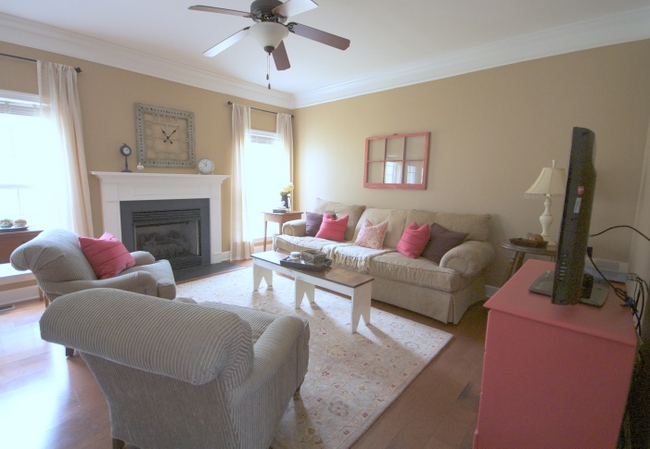 messy tv wires and ceiling fan strings
messy tv wires and ceiling fan strings
If you are taking photos yourself, try to minimize any editing by tucking away cords or simply alter a shot’s angle slightly so as not to see something you don’t want to see in the final photo.
 wires behind tv cropped out, ceiling fan cords removed
wires behind tv cropped out, ceiling fan cords removed
Just like with stagers, designers, and Realtors, there are good real estate photographers and there are not-so-good ones. Thankfully, I work with some really great ones that understand what I need when I hire them.
Professional photography is so important for capturing staged or designed interiors, so hiring a real estate photographer who understands these six things can make all the difference in the results. Are there any other things you wish real estate photographers would do?

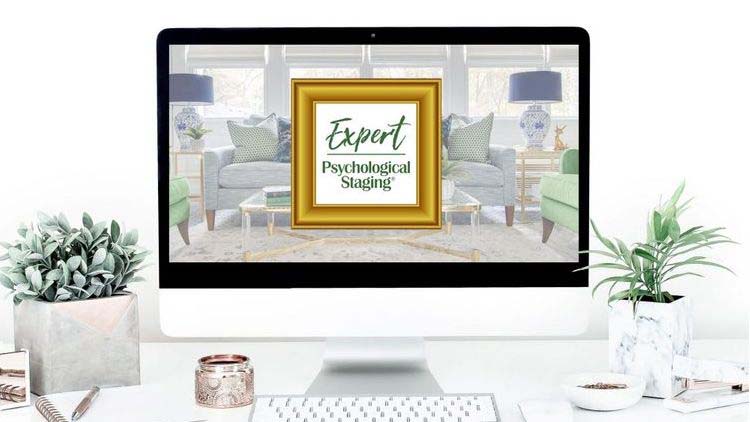
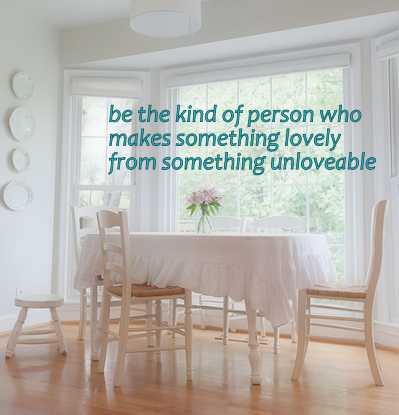
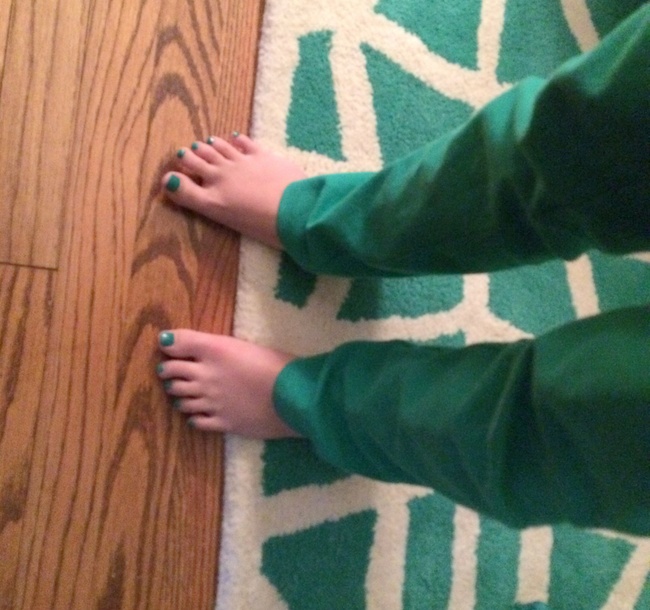
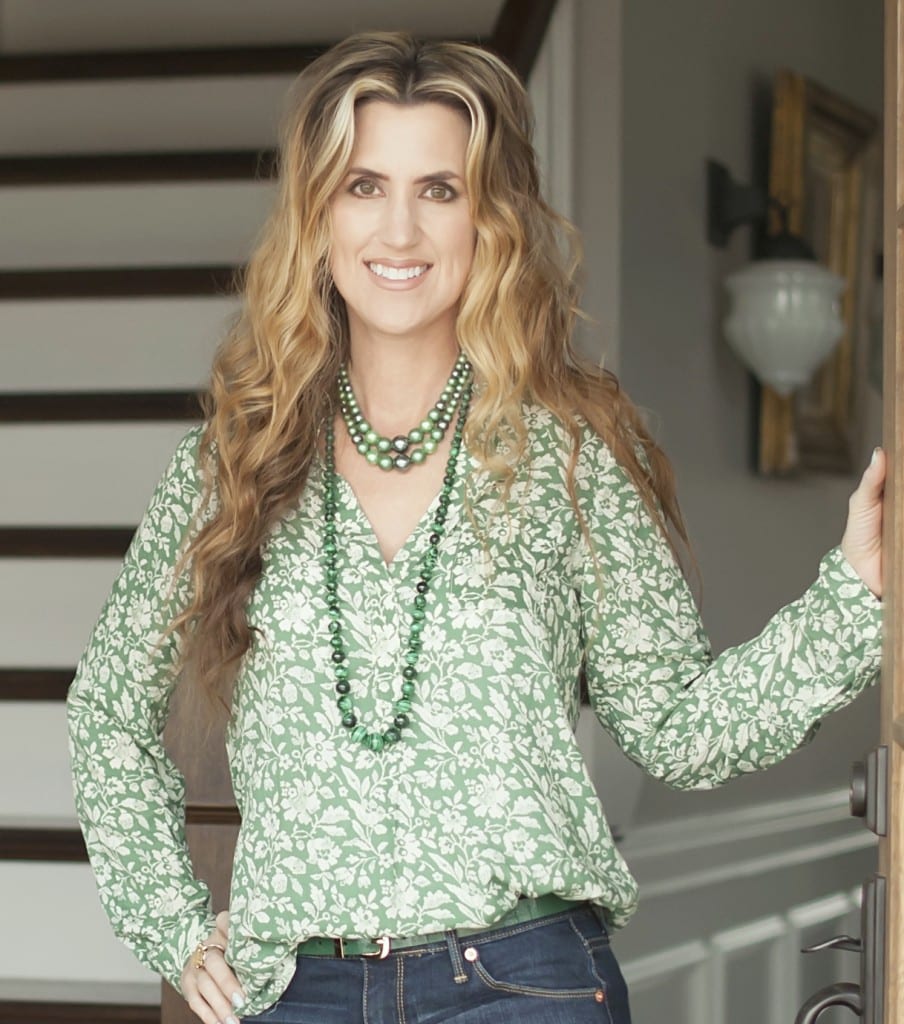
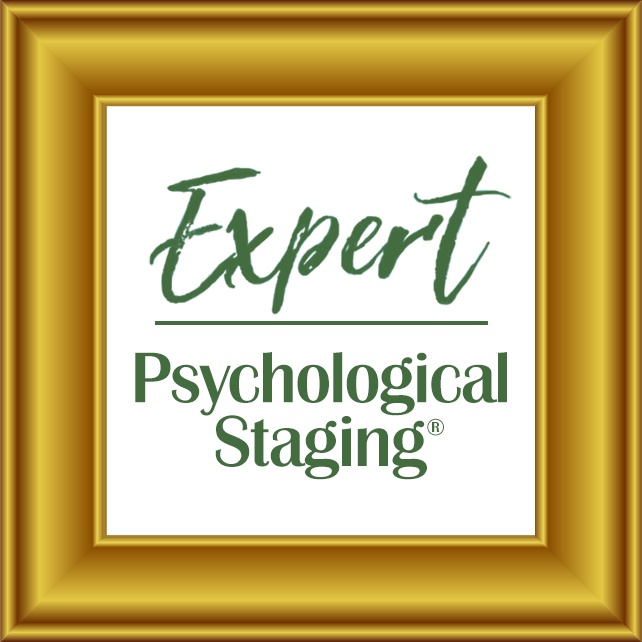


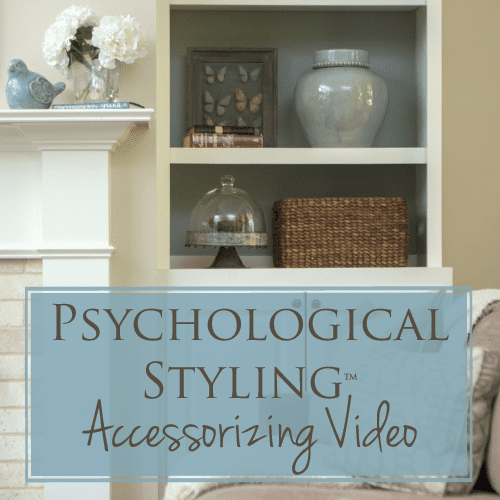
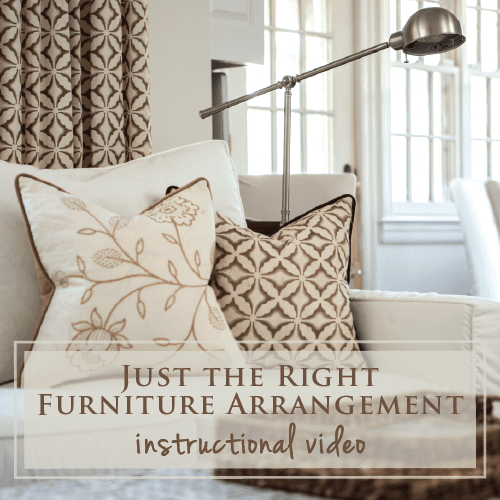
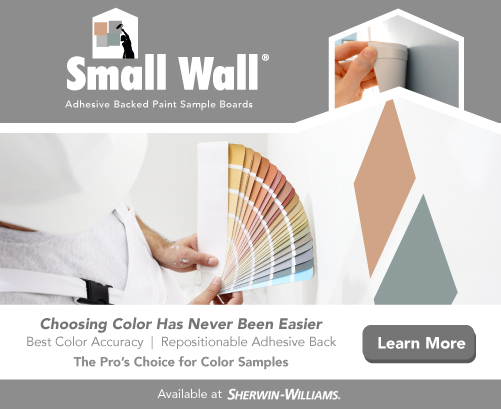
yes, yes, YES!~!!
Another amazingly insightful article, Kristie. Thanks for sharing! I just got my real estate license last week and hopefully will be able to use these tips to direct the real estate photographers whenever I, hopefully , get my first listing! Most of the MLS listings in my area don’t appear to have been shot by a professional photographer –or they don’t look professionally done, at least! (I live in a rural to semi-rural area so I’m not sure if there are many photographers specializing in real estate around here.) One thing that really bugs me, too, is that so many of the listing photos (at least in my area) have had their contrast settings adjust too high–probably because of a “tip” I’ve heard going around real estate agent advice circles that setting the contrast high makes your photos “pop”. Well, most seem to do it way too much and it makes the photos look like old, grainy magazine photos that have aged, imho. I think it looks hideous! Have you seen that trend in your area, too?
If a room doesn’t have enough natural light, does it work well for a professional photographer to bring in special photography lights and those reflector umbrellas, etc to lighten up a space?
I have noticed that many listing shots have the curtains or blinds closed–I assume to avoid back-lighting from the window. Do the tips you suggested, about metering on a darker part of the room, fix this problem so you can have a shot looking directly through an open window? Just wondering.
By the way, do you have many real estate agents take your course? I would like to be able to advise clients with occupied homes how to stage them for better resale, etc. We don’t have many stagers, especially who do occupied homes, in our area. Thanks.
Thanks, Phyllis! I think you are referring to HDR photography, and yes, many people over-HDR their photos, in my opinion! It can look great, if you know what you’re doing, but some people rely on it too heavily. Special photography lighting and reflector umbrellas can be very helpful, and professionals can use those to balance lighting. Metering on a darker spot does help with the window issue, but there are other ways to handle that issue – that’s just a good hack for us non-professionals! In answer to your last question: yes, I often have Realtors take the EPS™ course to become certified home stagers. I highly recommend dividing out Realtor and staging responsibilities between partners or on a team – it’s very difficult to handle both jobs, and it’s so important to separate the two responsibilities so that your seller trusts your recommendations. Husband-and-wife teams or female partners do really well when one takes on the role of the stager and the other the business expert, at least in the eyes of the seller. I’d love to have you come take the course, Phyllis 😉
Re: “metering on a darker part of the room” – Instead, you can bracket your shots so you get one brighter, one darker and one ‘average’. Then do an HDR merge (through your camera or software) and then tweek the result ever so slightly. Hope this helps
Thank you for that advice, Andrea!
Kristie, this is excellent information!!
Thanks, Carolyn!
Great tips Kristie, thank you!
No problem – I hope it’s helpful!
I am always amazed at home many bathroom pictures have the lid open on the commode…doesn’t anyone look at the image…I find it helpful to take pictures of my rooms from time to time, it gives one a different perspective of the image your eye has become accustom to every day…it always helps me remove distractions and clutter.
Me too, Kelly! Taking photos of your own rooms helps you see things you don’t notice when you live in them every day – we go blind to our own stuff, don’t we?
I’m a new stager who didn’t take your course, but I’ve purchased your books and love all your advice and style!
As a realtor in a highly populated suburban area, I am constantly amazed at the photos that are on the MLS, even for some high end homes. Open toilets, clutter, dirty dishes in the sink, closed window treatments with horrid blinds/drapes…who aspires to live that way? sigh*
Thank you for sharing this post
Hi Jill! Oh, and bug spray on kitchen counters – I’ve seen that more than once, ugh. Of course, those are the homes that are not staged and where professional photographers aren’t coming in to take the photos!
As a professional real estate and architecture photographer who has photographed almost 800 homes I can attest there’s an interesting dynamic taking place between what the client (often Realtor) wants, what the stager wants and what the photographer wants the photos to show. Typically the stager and photographer want to shoot a bit tighter and with more dramatic lighting, real estate agents want w i d e and bright more often than not. Builders and remodelers are somewhere in the middle. They want a little more focus on specific details. It’s a bit of a juggling act.
James,
I’m sure that it is a juggling act, trying to figure out what exactly your client is looking for and also trying to be true to your craft the instinct you have when you are creating good photographic images. Good photographers are worth their weight in gold!
Good article and as an interior photographer don’t forget to mention to pay your photographers fairly for their services and any extra work you may request which may include extra retouching and delivering high resolution files. We are trying to make a living too. Too many real-estate agents want to find the cheapest photographer and this is what you get as shown in your article. There are a lot of talented RE photographers who are getting the short end of the stick because agents have gotten burned by bad photographers.
Absolutely, Michael! When I ask photographers to do extra work, I know that means extra compensation. As for your comment regarding real estate agents wanting the cheapest photographer – the same is true for home stagers. Cheaper never means better!!!
Lol we are on the same page. I want to deliver the very best and it is wonderful to be apreciated.
Thanks for commenting, Michael! I really do appreciate good photographers – they are very important to the real estate and home staging industry 🙂
Thank you for providing this insight into your perspective Kristie! I shoot RE photo/video as a side hustle and it is helpful for me to digest perspective from another discipline within the industry. Many times, my clients are so focused on getting decent photos for cheap, that they miss the concept that I am trying to create marketing materials that illicit real desire from prospective buyers. More time spent in the psychology+education field would probably reap additional sales. Thanks so much for your words and time -AW
Thank you so much for your input and insight, Adam!
Great article…. though i have to point a few things out.
1. 2nd paragraph – “steady as she goes? – Use a tripod – Most RE photographers should anyway.
2. Artificial lighting – Photographers can normalize it though lighting temperature correction.
3. The right angles – Photographers are actually great at composition and will get a few angles of the same room.
4. A wide angle lens IS NOT a fish-eye lens. Two totally different things.
5. Its easy to ask the photographer for High-Res images….. sure you might have to pay a little more but just ask!
6. Excessive wires, Yes….. Outlets….not so sure. Sometimes a buyer wants to see where outlets are. But yes… i half agree with you here.
What I get from this, is the fact that there may well be a little misunderstanding of a professional photographers role. Probably not all your fault though. Have you ever spoken to any of the photographers that image your work? Have any of the photographers invited you to give them guidance on how you would like certain shots? – the latter question I feel may be a little more the reason you haven’t got what you wanted. Communication is key to getting what you want. 🙂
Thank you for your input, Colin.
Communication is definitely key – which is why I wrote this article. Home stagers and interior designers need photographic results that are worth their monetary investment. Just like all stagers/designers are not alike, all real estate photographers are not alike.
Although I realize that professional photographers can normalize lighting and color through lighting temperature correction, I find that some do a better job of that than others. When I’ve specified the paint colors in a home, I want to be sure they are accurately represented – and many times they have not been (even when photographed by professionals).
My apologies for not using the term of the wide angle lens correctly. The image I showed of the chair with the distorted arm is from a real estate photographer I hired to shoot a staged property last fall – the “fisheye” effect is what I was referring to, and I certainly don’t know the names of the all the lens.
I always speak with real estate photographers that image my work, but I didn’t used to. Most of us assume that they will work in a certain way and can be disappointed when the images don’t turn out as well as they could have, if only we communicated what we need from the shoot.
Thank you for reading and commenting!
Ugh, another agent just bitching. Even starts the article by saying “I’m no professional, but THIS is how to take pictures.” What a joke
Hi Don,
Actually, I’m not an agent – I’ve been in the home staging industry for 14 years, and I know that good staging and good MLS photography are key to getting buyers in the door. I’m guessing you didn’t read the last few sentences of the article?
” Just like with stagers, designers, and Realtors, there are good real estate photographers and there are not-so-good ones. Thankfully, I work with some really great ones that understand what I need when I hire them. Professional photography is so important for capturing staged or designed interiors, so hiring a real estate photographer who understands these six things can make all the difference in the results. Are there any other things you wish real estate photographers would do?”
If you don’t want wires or clutter then you should manage those before the photographer shows up. Otherwise you can expect the cost of the shoot to go up.
Most other points here are valid, but can be EASILY avoided by simply telling your photographers your expectations. The photographers will either let you know your expectations are unreasonable or they will issue you a new quote for the work to be done to your standards.
Finally, please don’t assume that real estate photographers are the same thing as commercial photographers or architectural photographers. They’re not.
Frank,
I agree that communication is key when working with photographers. This article was written with home stagers, designers, and home owners in mind – and what they need to be sure to communicate when they hire a professional real estate photographer. Thank you for sharing your thoughts!
Just like with everything, you have the photographer who is of “fast food” quality and price…and you have other photographers who are more like a chef of a fancy restaurant..with the quality and price that come with it…Some clients just want a cheap burger…others want something more.
Very true! Thanks for your comment!
Hello Kristie,
Out of curiosity, how much do you pay for a real estate shoot?
Raffi
Stupid article.
You void all your credibility at DEMANDING hi-res photos.
You are the epitome of a BAD CLIENT.
If you want Hi res images, YOU MUST PAY FOR THEM, NOT EXPECT THEM
We run businesses not charities!
Not using artificial light and expecting us to be your clean up crew
What a joke!
Not even going to go into how pointless the rest of this article is.
Jack,
Well of course I pay my photographers. I’m not sure why you think I can’t ask for hi-res photos from a photographer I am paying to do the work. Isn’t it your job to attempt to give your clients what they are asking for?
Jack why would you not give the full resolution pictures to the client? Once you did a listing, why would you want to keep the “rights” of the pictures?
nasty comments in caps just voids all YOUR credibility. I’m assuming your pics are Town & Dump quality on a budget, are they? Leave the toilet brush and litter box where they are. It’s too expensive to ask the stager or seller to remove them.
Go away.
A lot of these points are problematic. “Don’t use artificial lighting” is bad advice. It should more be “Do not use artificial lighting if you do not know how to use it and balance it properly for both exposure and color.” The image you use for point 3 uses artificial lighting and it they did not they would have had to resort to excessive HDR to fill in the furnature. Of course photographers with this level of skill will cost significantly more
Under wide angle, neither of those images use a fisheye lens you claim the one with the couch is distorted because of a fisheye, however it is clearly not a fisheye, and the metadata states that is not… it’s just an ultra wide and they were too close at a bad angle to the couch for such an extreme wide angle.
Asking for hi-res. That should be in the contract, you should also define what “hi-res” is, because the definition is not clear.
Thank you for your insight, Kurt. Because stagers aren’t professional photographers, they don’t always know what to ask (or even know the proper language) for from the photographers they hire. Obviously, my understanding of a fisheye lens isn’t accurate – I apologize for my ignorance on that point and assume I should just refer to it as an ultra wide angle lens in the future. I must say: I can’t imagine if I asked a photographer if they know “how to use artificial lighting and balance it properly for both exposure and color” that he would say no. In fact, I’ve had real estate photographers assure me that they would be able to adjust to get the paint colors correct, while the results proved they did not. Photographers may not realize that stagers and designers are wanting specific things that Realtors may not be asking for, such as the ability to crop to create vignette shots (for social media and portfolios) and very accurate representation of paint colors (for those, like me, who specialize in specifying paint colors for homes). Good communication is key, so thank you for sharing your thoughts!
I think too many of the RE photographers commenting here aren’t understanding that you are approaching this from a stagers point of view and NOT from a RE agent. Your title doesn’t help much in that regard. The end goal is the same obviously (to help sell the house), but there are some subtle differences in what is needed for each. POV, more tighter shots etc. that can be used for other things beside the listing.
The problem I have with not using artificial lighting, is that sunlight during most of the day has a blue cast to it, your example above has that color cast. As a matter of fact, all of your examples have a cool blue cast to them. Blue is typically seen as cool/distant by viewers, generally not a good look. Yes, it can be color corrected, and should be to a more warmer look. Artificial off-camera lighting (off-camera being important) gives you the ability to more easily get consistent color across the image.
Shouldn’t #6 be the primary responsibility of the stager..?, while the RE photog should help out with proper composition for those things that cant be easily hidden.
And to the RE agents complaining about the poor quality of images on your local MLS, the culprits are none other than your competition (i.e. other agents) who don’t see the value in hiring a RE photographer, so instead they use their cell phones to get “good enough” images. Granted, in hot markets houses can sell before images even hit the MLS, but what is going to separate you from the competition, when the market cools off again. Getting the best images not only help to sell the existing listing, but they become a valuable marketing tool when going after the next listing.
“The problem I have with not using artificial lighting is that sunlight during most of the day has a blue cast to it,”
If you’ve ever seen the lighting study by Monet of Rouen Cathedral, it can be demonstrated that sunlight changes hues throughout the day.
https://en.wikipedia.org/wiki/Rouen_Cathedral_(Monet_series)
add to this the colour of the walls and the way they reflect the light. It’s more complex. Photographers need to be trained in light/colour theory.
I like how you said that you should make sure you take photos from the right angle. I am selling my home this year and need to get some pictures taken. Thanks for the tips on real estate photography.
You’re very welcome, I’m glad it helped!
Thank you for providing this insight into your perspective Kristie!
You are so welcome!
Great tips!
Love this article. It’s valuable to see a stager who is trying her best to understand the technical side of RE photography in order to communicate how she wants her work represented. As a RE photographer, it’s a good practice to really listen to these types of requests and try understand the needs and goals of another profession. As the comments show, some photographers, including myself, would offer a counter to some points on this list, but doing so respectfully is how we work toward a mutually beneficial strategy and potentially begin a partnership. As the author states, it’s all about communication. Whatever your trade is, work on being good at sparking up synergy. Recognize and acknowledge professionals who are able to understand and compliment your work and then actively build those partnerships.
So well said, Tim! Thank you for contributing to the conversation.
That is true! I really want myself to follow all these points.
I’m so proud of you for posting these tips. All valid points to keep as rules when shooting a space. I’m a photographer myself and could not agree with you more on these 6 and could even ADD to your list. Like…put the toilet seat DOWN and avoid your reflection if anything reflective is in the room. 😉
Big hugs to you and all your readers. I love your work.
Thank you so much! I’m with you on the toilet seat and that mirror issue – that’s the trickiest thing about trying to photograph a room where there’s a mirror head-on! It’s always best to hire a pro to do it right. 🙂 I appreciate your input!
A good photographer will use artificial lighting and make sure the windows are not super bright, which is usually the first clue of a beginner when the windows are super exposed and too bright.
This information is helpful to those who have just started real estate photography. These are common mistakes that photographers need to avoid. Thanks Kristie!
Cannot agree more! Real estate photography definitely takes more effort than people think. Thanks for the article Kristie!
I think you can solve all your problems if you hired the right person. Don’t hire a Real Estate Photographer, but hire a Architecture or Interior photographer. Different skill with different pricing and different results. You hired the wrong person and then try to blame them?
I totally agree with you on get more flooring and less ceiling. It’s so annoying when you are looking at a property’s pictures and all you see the pictures of walls and ceiling.
Absolutely love your point of view. I 1,000% agree. I love imagery with the lights turned off. Those are the architectural mag covers and hero shots.
The problem I run into is that almost all real estate agents want the lights turned on. Since they’re the ones hiring, I cater to that. During architectural shoots the lights are most definitely off 99% of the time.
Thanks, Erik! Real estate agents want that because they don’t know any better – when they used to take their own photos for listings, that was the only option a novice knew for brightening up the space. It’s become a default for real estate photography. And that’s why “lights on” looks so passe now. It’s about educating agents, really.
Great article, full of very specific tips. I truly reckon that real estate is the most popular business in the world & it all starts with image, the picture of the dream home.
I am a little late to this discussion but wanted to give my two cents anyway.
Not all RE photographers are created equal which also goes the same for clients with needs that may differ depending on the market, the client’s use for the images etc.
Let me address each one of your points:
1. Get more flooring, less ceiling.
I think this is pretty subjective. However, although there is no “correct height” for a tripod, the image should convey what the buyer would see walking through the house. That being said, the image should include both the floor and ceiling with the floor being slightly more prominent unless the ceiling architecturally stands out. I also shoot so that the client can see the tops of the counters, tabletops, desks etc. In the end, very subjective. Communication is key!
2. Don’t use artificial lighting.
I would say bad idea generally speaking. Indoor artificial lighting is typically used for “ambiance” and can dramatically change the look of a room. Any good, professional RE photographer will make sure the white balance is appropriate for the space and also adjust in post if need be. This is standard in the industry with experienced, professional RE photographers.
3. Take photos from the right angles.
This certainly can also be very subjective when we are talking RE photography. Professional RE photographers will take consistent multiple angles that show each room from a different vantage point AND show it in the best light, for potential buyer’s.
4. Beware the wide angle lens.
ALL RE photographers should be using wide angle lenses, which are NOT considered “fish-eye” lenses. You mentioned that you did not know the difference in lenses so it is understandable that you were not clear about your comments on wide angle lenses.
Again, any RE photographer worth their weight will use the correct lens for the job and take images at the best angle for the room when possible.
5. Give us the hi-res (not web-sized) photos:
At this point, (2021), if the photographer is not delivering Hi-Res images, find another photographer. Subjective, I guess, but I stand on that opinion.
6. Take care of wires, outlets, and distractions.
This is something that, generally speaking, is the real estate agent’s responsibility. I give all of my clients a checklist of things to be done by the homeowner before I show up for the shoot. A good agent will show up early to the property to make sure it is “model home ready” to the best of their ability.
Of course, when I arrive, I will do a walk through and make suggestions to the homeowner and agent to move or hide unsightly items that you discussed in your article. I will also try to hide, photograph at an angle or crop so that things like wires and cords are not seen.
Digitally removing items from an image, almost always, is an extra fee and can be time-consuming. It can be very difficult to remove some of those types of items even with a very experienced and skilled editor.
However, in the end, it is the sole responsibility of the agent and homeowner to make sure that the home is ready to be photographed on the day of the shoot. When I have 5 shoots for the day with each at a scheduled time, it is imperative that the agent and homeowner do their due diligence so that when I arrive, we are ready to go.
In the end, it all boils down to communication with the photographer about what exactly are your needs and what type of images you need. Hope this helps 🙂
Thank you for your input, Mark! I appreciate you taking the time to share your view from a professional photographer’s perspective.
What a great blog. In the times where every industry is moving towards going all virtual & online, the above information really helps the transition to create a better experience for real estate. Along with professionals, this also facilitates learning real estate photography for newbies. Thanks!
switched table lamps look very cool&sweet and if you have a problem with over warm color tone in photoshop you can adjust in a second…
Hi Kristie,
You nailed it. It’s better to choose a real estate photography expert. The same thing goes with real estate videographers, Most of them use fish eye lenses. I don’t know that effect seems unrealistic to me. It adds the size of the property. That could make potential buyers disappointed when they see the actual size.
Marie,
I agree about the fisheye! Totally deceptive to buyers.
Harmonious and beautiful photos are really important when selling or renting an apartment. The potential client should get a perfect first impression about your apartment then you’ll have more chances for a successful deal. That’s why I always try to make the best possible photos and your tips are really helpful, thanks for sharing!
Well written content.
I have read this full article and found it very informative as you have covered all the aspects of real estate photography. Moreover, you have explained every point in depth. So, users can easily find the thing which they are here for. Your tips are definitely going to help a lot of aspiring real estate photographers in advance and they will be able to avoid the mistakes in advance.
Sounds like you need a architecture photographer and you better be ready to pay for it.
Great advice!
Thanks for the great post. I found it really interesting and it definitely gave me a lot to think about. As someone who is in the real estate photography business, I especially appreciated your point on capturing more of the flooring than the ceiling.
I completely agree – too often photographers focus on capturing details that aren’t really important, like the ceiling, and they lose out on getting shots of the flooring which can be really valuable. It’s something I struggle with myself from time to time.
I just skimmed this article. About your complaints you had with your photographers. I am a professional photographer and love doing architecture photography and studied at the Academy of Art University in San Francisco. It sounds to me that you are hiring amateur photographers who are telling you they’re professional photographers. Your complaints are things that professional photographers already know and are trained to deal with. I found them to be very basic things that professional photographer already know. I know real estate companies in general do not want to pay what they need to pay professional photographers to shoot. We don’t come cheap. And you’re also going to have to pay rental fees for all of our equipment that we use. I found that real estate companies don’t want to pay those fees. Real estate companies when they start their business need to budget for professional photographers if you don’t you’re going to be stuck hiring amateur photographers who don’t know these things.
While I’m late to the conversation, I’m early in my RE Photography and grateful for your perspective. Even adding a few of these to my brief questionnaire for clients because it’s so subjective. Thank you for sharing the staging perspective!
You are so welcome, Cassandra! Best of luck in your photography career. 🙂
You won’t have to worry about lazy real estate photographers much longer. A I will soon be doing all of that for you.
This article is helpful in its common sense response to rampant tacky real-estate photography with questionable skill levels.
Sellers trust that the agent will either do the staging himself and delegate instructions to prep the seller in advance or will hire a stager. It can be a shock as a first-time seller to see the result of a photoshoot without any communication between the photographer, the agent on site, and the seller. A “photographer” in a rush to get to his next job, will sacrifice quality by relying on tools to tweak images later, making the property look cheap, dingy, and weird. Add to this an agent who doesn’t know how to delegate or take charge and you end up with dumpy pics and overused modifying tools.
Commenters quibbling about the wrong words used to describe a prevalent stretched look to photos are trying to shoot down the messenger trying to bring a valid message to an industry rife with unprofessional youtube-taught “photographers”.